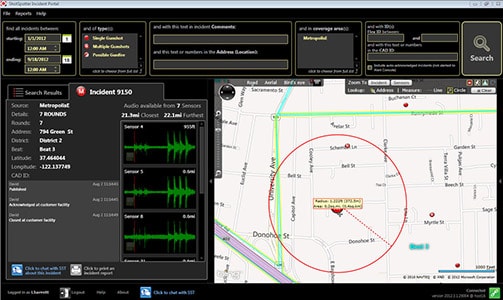This edition of our Police Tech series examines gunfire locators, another addition to the arsenal of technological tools that help improve police response times, preparation and potentially lower crime. In one situation, a mass shooter was in custody 4 minutes and and 13 seconds after his first shot, with police attributing their speed to gunfire location technology.
These tools have been implemented for nearly ten years across the country and have been generally well received by law enforcement departments and the communities where they’re located. There are several kinds and the most popular comes from ShotSpotter Inc.
What is a “gunfire locator?”
Gunfire locator technology is a tool that automatically detects gunshots fired and notifies law enforcement for response. These devices combine microphones that “hear” the gunshots, optical sensors that “see” muzzle flashes or heat caused by bullets traveling through air, processing software that determines if gunshots have been fired, and finally display interfaces that identify gunshots have been fired along with the locations of activity on maps.
How does it work?
The ShotSpotter process takes between 30 and 45 seconds and works with microphones that are typically set up with 15-20 sensors per square mile each about 30-40 feet off the ground. Each sensor is built to ignore ambient noise and detect loud sounds. Recordings of the loud “booms or bangs” are sent along with the time and location of the sound to software that triangulates the origin of the noise. An alert is then sent along with the recording to human acoustic experts who are trained to recognize whether the sounds are gun shots. In those cases where a gunshot is detected, the experts send an alert to its local 911 dispatch center.

Where is it used?
ShotSpotters are deployed in about 90 cities including Baltimore, Camden, Milwaukee, Minneapolis, New York, Philadelphia, Washington D.C., and West Palm Beach.
What’s the success and impact?
What the police departments do with the data generated by ShotSpotter technology is up to them, but there are several implications and possibilities. In addition to faster response times to gunshots, it is possible to use the data to plan patrols and adjust resourcing. Overall, police departments that have implemented ShotSpotters have welcomed the impact despite a 2016 Forbes report after an in-depth data analysis finding that police were unable to find evidence of gunshots in 30%-70% of reported gunshots. After implementing ShotSpotters in Camden, NJ, once labeled the most dangerous city in America, gunfire has gone down by 50%. Springfield, MA has also decreased 50% and Oakland, CA has a 71% reduction.
Capt. David Salazar of the Milwaukee Police Dept says it saves lives and more importantly allows for better targeting and improved community relations. In New York, 911 reported that shots fired rose from 20% to 34% and found that 18 guns were found due solely to ShotSpotter alerts. More importantly, in New York as in other cities, the impact on community relationships with police was better communication and increased engagement.
What’s next?
Ralph Clarke, CEO of ShotSpotter, has said, “there’s probably a need in about 1,000 cities in the U.S. There’s a global need, as well, in Central America, parts of South America and parts of Africa, South Africa primarily.” With the successes reported across the country, additional implementation seems to be a logical next step. Some police departments are hoping for ways to connect eye witness accounts to reports. Whatever the technological innovations that come, police in the cities that have them are grateful for the assistance that gunfire locators have given them and the communities they serve.








